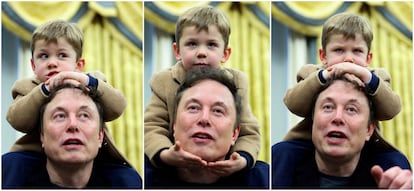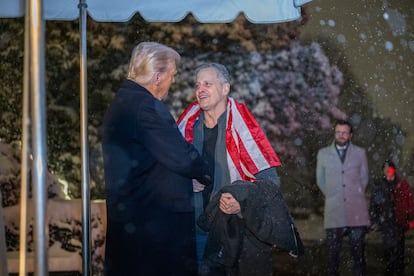Trump 2.0: A presidency aired live 24/7
Musk in the Oval Office, televised signings of executive orders, announcements on board Air Force One... With his return to power, the US president is taking the concept of politics as spectacle further than ever


Tuesday was a special day on the big set of Donald Trump’s White House. The programming schedule started in the morning with a visit by the King of Jordan and the classic fixed shot reserved for heads of state, with the U.S. president on the right, the visitor on the left, and the fireplace in the background. Audience ratings peaked when the afternoon slot began, with a staging that made more than one person rub their eyes: Trump sitting behind the desk in the Oval Office, and Elon Musk, his richest ally, standing next to him with his four-year-old son on his shoulders or walking around. The broadcast stretched into late-night programming, with images of the president going out to the gardens of the White House to greet Marc Fogel as snow fell on Washington. The U.S. citizen had been released that day from a Russian prison, where he had been “wrongfully detained” for three and a half years, according to the State Department, and he showed up wrapped in an American flag.
It must be said that the day was certainly full of good television material, although nothing could compare to the spectacle of Musk, who answered questions from reporters for half an hour about his plans to shrink the federal government, which have been questioned in the courts. It was a historic broadcast, not only because of the fact that the richest man in the world was standing inside the space with the greatest symbolic power on the planet, or because of the surreal presence of a child running around, but also because of the exceptionally rare sight of Trump keeping quiet as he listened to someone else speak. It was an attitude without many precedents in his long career as a reality TV star, first, and as a champion of politics as a show, later.
“He has always been a showman, and proud to be, as he himself said years ago, ‘a ratings machine,’” said the journalist Margaret Sullivan, who was a public editor at The New York Times and a media columnist at The Washington Post during the first Trump administration, in an email. “Now that he is president again, he has not stopped behaving that way. Part of it is because he craves attention, but it’s not only that: he is constantly performing in front of his base of voters and followers. They are the ones who give him so much power because they believe him and approve his decisions, no matter what he says or does. It is his talent for manipulating the masses.”

Beyond the time when Musk spoke, Trump has not been too silent in his first 24 days in the White House. And, it is only fair to say, he has permanently kept a channel of communication open with the traditional media, which he claims to hate but which he is always alert to. At the moment, he has been speaking to the media almost daily, even more so than at the beginning of his first term.
Most of the time, he does so several times a day, but there is one in particular that stands out: when he locks himself away with a handful of reporters to sign executive orders and answer questions. It is an unusual ceremony, broadcast by the news networks with a slight delay, in which an aide announces the measure to be adopted, hands the open file to Trump, and he signs it with a nod of approval and remarks such as: “This order is especially good!”

The contrast between this hyperactivity and the seclusion in which his predecessor, Joe Biden, lived during his presidency, four years in which he only gave 36 press conferences and rarely did so alone, gives arguments to his allies when they say that Trump is acting with unprecedented transparency, even greater than in his first term. Democratic analysts on cable networks also concede this much, as did CNN host Jake Tapper on Tuesday after the show with Musk. Seated at the debate table, Jeffrey Toobin, a veteran legal analyst, pointed out that this apparent transparency cannot conceal the forest of lies, exaggerations and half-truths with which the new tenant of the White House lines his speeches.
Washington’s ‘Newspeak’
Nor can it hide that this verbiage is trying to introduce a kind of Orwellian “newspeak” into Washington — for the moment, with considerable success — in which terms like “diversity” have become swearwords, Spanish has disappeared from the White House website, and the reporter (but not the photographer) for the Associated Press, the largest news agency in the world, has been barred from the Oval Office because the AP refuses to rename the Gulf of Mexico in its Style Book (as Apple and Google have already done in their navigation tools), which Trump has decreed should be called “Gulf of America.”
The writer Stephen Marche, author of the essay The Coming Civil War: Dispatches from the American Future, explains that Trump’s strategy also involves a “flood-the-zone” strategy, a very Washingtonian concept coined by former Trump White House chief strategist Steve Bannon in 2018: it consists of hijacking the attention of the media and society by flooding the channels of public attention by doing many things at the same time, without even a break to allow for indignation. “The idea is that it is not easy to keep track of him and, consequently, that we do not know exactly what is really going on,” Marche believes. “He has the soul of an executive television producer. He not only thinks according to that logic, but he organizes his messages so that the audience, to which he is addicted, never wanes. And Americans? They are used to that circus. They are especially vulnerable to manipulation.”
Last Sunday was another good example of this policy. Trump made history by becoming the first sitting president to attend the Super Bowl in person. As if that television opportunity, during which he saluted the anthem with his hand on his forehead, was not enough, he took advantage of the trip to New Orleans by plane — specifically, when Air Force One was flying over the Gulf of Mexico — to sign a decree on the issue of the name change. Then, when the game was over, he announced the death of the one-cent coin. And on Monday, in view of the low ratings, he dropped the news that he had ordered a ban on paper straws and returned plastic ones to the soft drinks and glasses of Americans.
As a result of this approach, the legion of reporters covering Washington are exhausted, facing endless shifts, constantly on edge and in turmoil, just like the global audience they serve. How the media (and civil society) can regain what Marche calls “attention control” is an open debate. “The press has always had a hard time figuring out how to cover Trump effectively,” adds Sullivan. “He’s not the same as traditional politicians, but journalists haven’t yet adapted to his way of being.”
The renowned journalist says that “perhaps the best decision is to cover the effects of his actions (or their possible effects) rather than getting carried away by the show itself. Although, of course, this is difficult to do, because [the American president] is constantly generating news with his latest scandals. And the role of the media is to cover that news,” she adds.
Trump and his people, obviously, do not care about these debates, just like they don’t care about institutional decorum. They have no time for such matters; the show (of politics) must go on.
Sign up for our weekly newsletter to get more English-language news coverage from EL PAÍS USA Edition
Tu suscripción se está usando en otro dispositivo
¿Quieres añadir otro usuario a tu suscripción?
Si continúas leyendo en este dispositivo, no se podrá leer en el otro.
FlechaTu suscripción se está usando en otro dispositivo y solo puedes acceder a EL PAÍS desde un dispositivo a la vez.
Si quieres compartir tu cuenta, cambia tu suscripción a la modalidad Premium, así podrás añadir otro usuario. Cada uno accederá con su propia cuenta de email, lo que os permitirá personalizar vuestra experiencia en EL PAÍS.
¿Tienes una suscripción de empresa? Accede aquí para contratar más cuentas.
En el caso de no saber quién está usando tu cuenta, te recomendamos cambiar tu contraseña aquí.
Si decides continuar compartiendo tu cuenta, este mensaje se mostrará en tu dispositivo y en el de la otra persona que está usando tu cuenta de forma indefinida, afectando a tu experiencia de lectura. Puedes consultar aquí los términos y condiciones de la suscripción digital.
More information
Archived In
Últimas noticias
From Andorra to Gibraltar, a black market for Ozempic exploits its success: ‘They’re the most sought-after products in the world’
From safe-haven investment to geostrategic weapon: Who owns the most gold and where are the bars kept?
Todd Green, head of the company that created ‘Candy Crush’: ‘Success for us is that players want to play for years’
Prices soar and Venezuela’s economy struggles under Trump’s pressure: ‘People are living day to day’
Most viewed
- Why we lost the habit of sleeping in two segments and how that changed our sense of time
- Trump’s obsession with putting his name on everything is unprecedented in the United States
- Charles Dubouloz, mountaineering star, retires at 36 with a farewell tour inspired by Walter Bonatti
- Venezuela faces its most tense Christmas yet
- CBS in crisis after pulling a report on Trump’s deportations to El Salvador (which later leaked online)










































